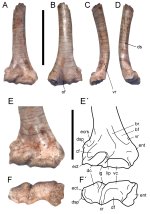Fred Ruhe
Well-known member

Gerarso Alvarez Herrera, Federico Agnolin, Sebastian Rozadilla, Gaston E. Lo Coco, Makoto Manabe, Takanobu Tsuihiji & Fernando E. Novas, 2022
New enantiornithine bird from the the uppermost Cretaceous (Maastrichtian) of southern Patagonia, Argentina
Cretaceous Research: 105452.
doi:10.1016/j.cretres.2022.105452. ISSN 0195-6671
Abstract: New enantiornithine bird from the the uppermost Cretaceous (Maastrichtian) of southern Patagonia, Argentina
Enantiornithes were the dominant avialan clade in the Mesozoic. However, their record for the Upper Cretaceous is scarce. In this study, we present and describe Yatenavis ieujensis gen. et sp. nov., one of the youngest occurence of an enantiornithine bird. The specimen, the distal half of a right humerus, was found in Chorrillo Formation, southern Santa Cruz Province of Argentina, making it also the australmost enantiornithine specimen recorded to date. Yatenavis is unique among enantiornithines for its combination of characters, including a crest on the medial side of the shaft which bears a muscular scar cranially; the presence of a dorsal supracondylar process proximal to the dorsal epicondyle; equally distally projected dorsal and ventral condyles; and a rod-like caudal extension of the ventral condyle bearing a distal sulcus scapulotricipitalis. Several of these features are shared with an unnamed enantiornithine recovered from Upper Cretaceous beds in another fossil site in Patagonia.
Enjoy,
Fred
New enantiornithine bird from the the uppermost Cretaceous (Maastrichtian) of southern Patagonia, Argentina
Cretaceous Research: 105452.
doi:10.1016/j.cretres.2022.105452. ISSN 0195-6671
Abstract: New enantiornithine bird from the the uppermost Cretaceous (Maastrichtian) of southern Patagonia, Argentina
Enantiornithes were the dominant avialan clade in the Mesozoic. However, their record for the Upper Cretaceous is scarce. In this study, we present and describe Yatenavis ieujensis gen. et sp. nov., one of the youngest occurence of an enantiornithine bird. The specimen, the distal half of a right humerus, was found in Chorrillo Formation, southern Santa Cruz Province of Argentina, making it also the australmost enantiornithine specimen recorded to date. Yatenavis is unique among enantiornithines for its combination of characters, including a crest on the medial side of the shaft which bears a muscular scar cranially; the presence of a dorsal supracondylar process proximal to the dorsal epicondyle; equally distally projected dorsal and ventral condyles; and a rod-like caudal extension of the ventral condyle bearing a distal sulcus scapulotricipitalis. Several of these features are shared with an unnamed enantiornithine recovered from Upper Cretaceous beds in another fossil site in Patagonia.
Enjoy,
Fred




